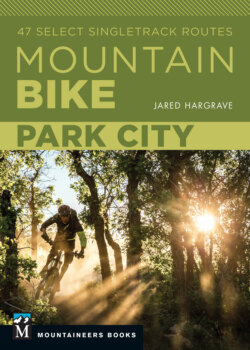Читать книгу Mountain Bike: Park City - Jared Hargrave - Страница 16
На сайте Литреса книга снята с продажи.
GEAR
ОглавлениеSo you want to be a mountain biker? Then you need to carry the right gear. First of all, you need a mountain bike. In this modern era there is no shortage in the variety of bikes you can ride. There are three wheel sizes—26, 27.5, and 29 inches. You can ride a hardtail bike or a full suspension one. Frames come in aluminum or carbon fiber. Mountain bikes are even categorized as downhill, enduro, trail, or cross-country. What bike you choose is really up to your personal style and preference. But for Park City’s trails, which are mostly buff and fast singletrack with a few technical sections, I suggest a full suspension trail or enduro bike. However, many of the smoother trails can be a lot of fun on a basic hardtail. Really, the most fun bike is the one you are currently riding.
Besides the bike, you’ll most likely need some specialized gear:
•Helmet
•Sunglasses
•Bike gloves
•Mountain bike shoes (either clipless or flats)
•Padded shorts or chamois
•Multitool that includes Allen wrenches, screwdrivers, etc.
•Spare tire tube
•Patch kit
•Tire levers
•Tire plugs (if you run tubeless tires)
•Air pump or CO2 cartridges
•Chain lube
•Chain tool and extra link
•First-aid kit
•Water bottle or hydration bladder
Tire-level view of the RTS Loop (Route 19)
It’s a good idea to carry all of these items, just to be prepared for any bike mechanical failures such as broken chains or flat tires. I like to carry a small backpack or hip pack, but you can divide these items up into frame bags. I also bring a packable rain shell in case of cloudburst or unexpected chilly weather.
In addition to the above mountain biking gear, it’s always a good idea to pack the Ten Essentials, a list developed by The Mountaineers. The point of this list has always been to answer two basic questions: Can you prevent emergencies and respond positively should one occur (items 1–5)? And can you safely spend a night—or more—outside (items 6–10)? Use this list as a guide and tailor it to the needs of your outing:
1.Navigation
2.Headlamp
3.Sun protection
4.First aid
5.Knife
6.Fire
7.Shelter
8.Extra food
9.Extra water
10.Extra clothes
Obviously, these lists are comprehensive. Packing everything on them would be overkill on short three-to six-mile rides. If the weather is perfect and the forecast looks clear, some food, water, sunscreen, and your repair kit are all you’re likely to need. It feels great to ride without the weight of a pack on your shoulders. But if you’re setting off on a longer ride that covers many miles and most of the day, then it’s best to be self-sufficient and bring all of the above items. Being prepared is especially important if you’re alone or planning on exploring trails at higher elevations and in more remote areas.
When you’re recreating at high elevation, drinking enough water is important, especially while mountain biking. A single water bottle on your bike frame is often not enough on long rides. The Institute of Altitude Medicine recommends drinking 1 to 1.5 liters of water daily when you’re above 5000 feet. Therefore, carrying a pack with a hydration bladder ensures that you have enough hydration for longer rides.
